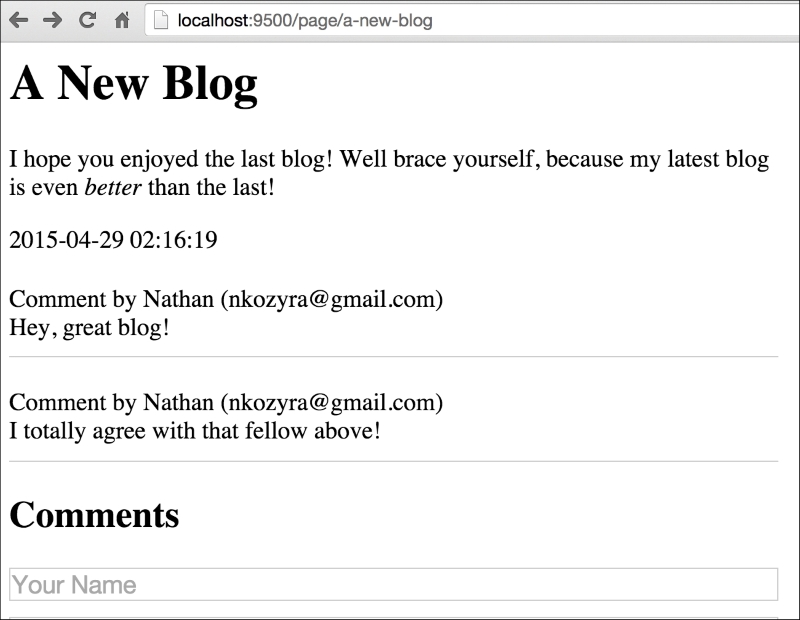Depending on whom you ask, PUT and POST can be used interchangeably for the creation of records. Some people believe that both can be used for updating the records and most believe that both can be used for the creation of records given a set of variables. In lieu of getting into a somewhat confusing and often political debate, we've separated the two as follows:
- Creation of new records:
POST - Updating existing records, idempotently:
PUT
Given these guidelines, we'll utilize the PUT verb when we wish to make updates to resources. We'll allow comments to be edited by anyone as nothing more than a proof of concept to use the REST PUT verb.
In Chapter 6, Session and Cookies, we'll lock this down a bit more, but we also want to be able to demonstrate the editing of content through a RESTful API; so this will represent an incomplete stub for what will eventually be more secure and complete.
As with the creation of new comments, there is no security restriction in place here. Anyone can create a comment and anyone can edit it. It's the wild west of blog software, at least at this point.
First, we'll want to be able to see our submitted comments. To do so, we need to make minor modifications to our Page struct and the creation of a Comment struct to match our database structure:
type Comment struct {
Id int
Name string
Email string
CommentText string
}
type Page struct {
Id int
Title string
RawContent string
Content template.HTML
Date string
Comments []Comment
Session Session
GUID string
}Since all the previously posted comments went into the database without any real fanfare, there was no record of the actual comments on the blog post page. To remedy that, we'll add a simple query of Comments and scan them using the .Scan method into an array of Comment struct.
First, we'll add the query to ServePage:
func ServePage(w http.ResponseWriter, r *http.Request) {
vars := mux.Vars(r)
pageGUID := vars["guid"]
thisPage := Page{}
fmt.Println(pageGUID)
err := database.QueryRow("SELECT id,page_title,page_content,page_date FROM pages WHERE page_guid=?", pageGUID).Scan(&thisPage.Id, &thisPage.Title, &thisPage.RawContent, &thisPage.Date)
thisPage.Content = template.HTML(thisPage.RawContent)
if err != nil {
http.Error(w, http.StatusText(404), http.StatusNotFound)
log.Println(err)
return
}
comments, err := database.Query("SELECT id, comment_name as Name, comment_email, comment_text FROM comments WHERE page_id=?", thisPage.Id)
if err != nil {
log.Println(err)
}
for comments.Next() {
var comment Comment
comments.Scan(&comment.Id, &comment.Name, &comment.Email, &comment.CommentText)
thisPage.Comments = append(thisPage.Comments, comment)
}
t, _ := template.ParseFiles("templates/blog.html")
t.Execute(w, thisPage)
}Now that we have
Comments packed into our Page struct, we can display the Comments on the page itself:

Since we're allowing anyone to edit, we'll have to create a form for each item, which will allow modifications. In general, HTML forms allow either GET or POST requests, so our hand is forced to utilize XMLHttpRequest to send this request. For the sake of brevity, we'll utilize jQuery and its ajax() method.
First, for our template's range for comments:
{{range .Comments}}
<div class="comment">
<div>Comment by {{.Name}} ({{.Email}})</div>
{{.CommentText}}
<div class="comment_edit">
<h2>Edit</h2>
<form onsubmit="return putComment(this);">
<input type="hidden" class="edit_id" value="{{.Id}}" />
<input type="text" name="name" class="edit_name" placeholder="Your Name" value="{{.Name}}" />
<input type="text" name="email" class="edit_email" placeholder="Your Email" value="{{.Email}}" />
<textarea class="edit_comments" name="comments">{{.CommentText}}</textarea>
<input type="submit" value="Edit" />
</form>
</div>
</div>
{{end}}And then for our JavaScript to process the form using PUT:
<script>
function putComment(el) {
var id = $(el).find('.edit_id'),
var name = $(el).find('.edit_name').val();
var email = $(el).find('.edit_email').val();
var text = $(el).find('.edit_comments').val();
$.ajax({
url: '/api/comments/' + id,
type: 'PUT',
succes: function(res) {
alert('Comment Updated!'),
}
});
return false;
}
</script>To handle this call with the PUT verb, we'll need an update route and function. Lets add them now:
routes.HandleFunc("/api/comments", APICommentPost).
Methods("POST")
routes.HandleFunc("/api/comments/{id:[\w\d\-]+}", APICommentPut).
Methods("PUT")
This enables a route, so now we just need to add the corresponding function, which will look fairly similar to our POST/Create method:
func APICommentPut(w http.ResponseWriter, r *http.Request) {
err := r.ParseForm()
if err != nil {
log.Println(err.Error)
}
vars := mux.Vars(r)
id := vars["id"]
fmt.Println(id)
name := r.FormValue("name")
email := r.FormValue("email")
comments := r.FormValue("comments")
res, err := database.Exec("UPDATE comments SET comment_name=?, comment_email=?, comment_text=? WHERE comment_id=?", name, email, comments, id)
fmt.Println(res)
if err != nil {
log.Println(err.Error)
}
var resp JSONResponse
jsonResp, _ := json.Marshal(resp)
w.Header().Set("Content-Type", "application/json")
fmt.Fprintln(w, jsonResp)
}In short, this takes our form and transforms it into an update to the data based on the comment's internal ID. As mentioned, it's not entirely different from our POST route method, and just like that method it doesn't return any data.
